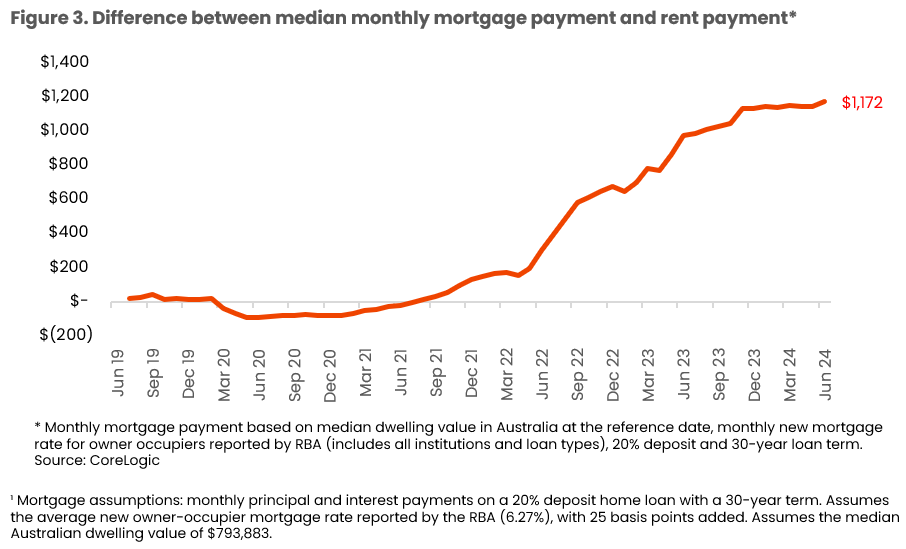Following last week’s Consumer Price Index (CPI) data revealing a 4.4% inflation rate for May, CoreLogic’s head of research Eliza Owen examined whether this could trigger another RBA cash rate increase and affect the housing market.
The monthly CPI indicator showed inflation increasing in the year to May, with the ‘trimmed mean’, annual inflation measure lifting to 4.4%, up from 4.1% in April. While the monthly CPI indicator isn’t as complete a measure as the quarterly inflation result, there is concern that inflation is back on the rise, which could necessitate another increase in the RBA cash rate target.
Why are housing values increasing despite higher interest rates?
The Australian housing market has been fairly resilient despite higher interest rates. Figure 2 shows the cumulative change in national home values from May 2022, showing an initial peak-to-trough fall of -7.5% from the start of the rate-hiking cycle through to January 2023, which marked the low point of the downturn in housing values. From the start of 2023, the cash rate would increase a further five times, but home values consistently rose, staging a recovery by November 2023, and rising further to be 4.6% higher than in May 2022.
There are a few explanations for why housing values have continued to rise even as the cost of debt has risen, and borrowing capacity has eroded. Part of the explanation comes from low supply relative to demand. Tight labour market conditions and an accumulation of savings through the pandemic have broadly underpinned mortgage serviceability, mitigating a need to sell as rates have increased, the construction sector remains squeezed, and unable to deliver a large backlog of dwellings, and strong population growth has increased demand for housing, both for purchase and rent. In the June quarter, there were around 127,000 homes purchased, but only about 125,000 new listings added to the market for sale. As long as there are more people willing to purchase a home than sell, prices should theoretically continue to rise. The composition of buyers may also be propping up purchases, with higher deposit sizes indicating the current buyer profile may be less debt-dependent than when interest rates were at record lows.
Other demand-side factors influencing housing purchases could be the predominance of variable rate mortgages in Australia. Buyers may be pricing in a future reduction in the cash rate to their purchasing decisions, with the expectation that they are buying in around the peak of the rate cycle, and their mortgage rates will trend lower over time. From this perspective, a further rate increase could certainly slow demand and signal to the market that interest rates are not yet at peak or at the very least, are likely to take longer to reduce.
Another rate rise would slow housing demand, and some cracks are already showing
Despite resilience in the headline numbers, there are some suggestions that demand is already weakening. National home values were up 1.8% in the June quarter, but this has slowed from a 3.3% rise this time last year, when the market was rising off a lower base.
Buyer demand seems generally skewed to cheaper markets, with Perth now being one of the primary markets driving growth in the capital cities. In the month of June, it is estimated that Perth accounted for 32.4% of the 0.7% uplift in CoreLogic’s capital city home value index. Adelaide has also contributed more to the headline growth figure through June (14.2%), up from 4.1% a year ago.
Another 25 basis point rise in the cash rate in August, all else being equal, would take monthly repayments on the current median dwelling value to over $4,000 per month¹. Not only is this further out of reach for prospective buyers, it would likely also represent a further blowout in the premium of holding a mortgage relative to renting. The bigger that premium becomes, the weaker demand for purchases may become relative to renting, despite rent growth still sitting well above average.

Figure 3 shows the difference between the median dwelling value mortgage payment, and median rent value estimate in Australia on a monthly basis, which was $1,172 in June. Assuming rents and housing values were steady in August, a further 25 basis point increase in average variable mortgage rates would push the mortgage premium to $1,276.
Should we actually expect an August rate rise?
The RBA have expressed an extremely low tolerance for any further uplift in inflation. However, there’s no guarantee of an August rate rise yet. The Reserve Bank’s own Deputy Governor noted last week that it would be a ‘bad mistake’ to base the August rate decision on one result, highlighting that quarterly inflation figures, the labour market report and retail sales data could also feed into the rate decision.
Other economists have pointed to the limitations of the monthly CPI measure, which does not always indicate the direction of the quarterly result. Westpac’s economics team had predicted the increase in the headline result to 4.0%, in part due to base effects. Despite ANZ and NAB now revising the timing of the first rate cut to 2025, none of the four major banks are anticipating another rate rise just yet.
However, even if rates do not increase further, housing purchases are expected to slow as economic conditions become weaker and affordability constraints play out. Labour force conditions are clearly starting to unwind, as job vacancies drop, employment growth slows and the unemployment rate rises lifts, which will limit new demand, and possibly weaken mortgage serviceability if mortgage holders become unemployed or work less hours. The household saving ratio has already weakened to just 0.9% of income in the March quarter, which will slow the accumulation of deposits for prospective home buyers, and impact savings buffers for households that own their home.


